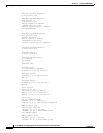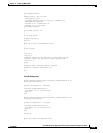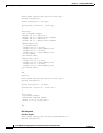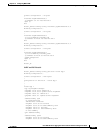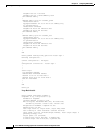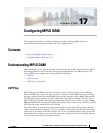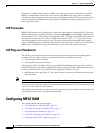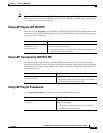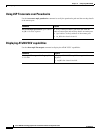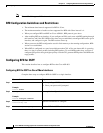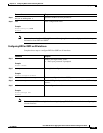
17-2
Cisco ASR 901 Series Aggregation Services Router Software Configuration Guide
OL-23826-09
Chapter 17 Configuring MPLS OAM
Configuring MPLS OAM
In response to an MPLS echo request, an MPLS echo reply is forwarded as an IP packet by using IP,
MPLS, or a combination of both. The source address of the MPLS echo-reply packet is an address
obtained from the router generating the echo reply. The destination address is the source address of the
router that originated the MPLS echo-request packet. The MPLS echo-reply destination port is the
echo-request source port.
LSP Traceroute
MPLS LSP traceroute also uses MPLS echo request and reply packets to validate an LSP. You can use
MPLS LSP traceroute to validate LDP IPv4 by using the trace mpls privileged EXEC command. The
traceroute time-to-live (TTL) settings force expiration of the TTL along an LSP. MPLS LSP traceroute
incrementally increases the TTL value in its MPLS echo requests (TTL = 1, 2, 3, 4) to discover the
downstream mapping of each successive hop. The transit router processing the MPLS echo request
returns an MPLS echo reply containing information about the transit hop in response to the TTL-expired
MPLS packet. The MPLS echo reply destination port is sent to the echo request source port.
LSP Ping over Pseudowire
The LSP Ping over Pseudowire is used for detecting faults in the data plane or forwarding path for
pseudowire services. The connectivity verification model for pseudowires consists of:
• Advertising the VCCV capability
• Verifying the data plane connectivity
Advertising the VCCV capability is done as part of MPLS Label Mapping message. This consists of
Control Channel (CC) type which is a bitmask that indicates the type of control channel that can be used
to verify connectivity. The Cisco ASR 901 router supports the following CC type:
• MPLS Router Alert Label (Type 2) : The control channel is created out of band and uses the router
alert label (RA).
Note The Cisco ASR 901 router does not support Control Channel Type 1 and 3.
Connectivity verification type defines a bitmask that indicates the types of CV packets and protocols that
can be sent on the specified control channel.
The LSP ping over pseudowire uses the same label stack as used by the pseudowire data path. Basically
it contains the virtual circuit (VC) label and tunnel labels.
Configuring MPLS OAM
This section contains the following topics:
• Using LSP Ping for LDP IPv4 FEC, page 17-3
• Using LSP Traceroute for LDP IPv4 FEC, page 17-3
• Using LSP Ping for Pseudowire, page 17-3
• Using LSP Traceroute over Pseudowire, page 17-4
• Displaying AToM VCCV capabilities, page 17-4



